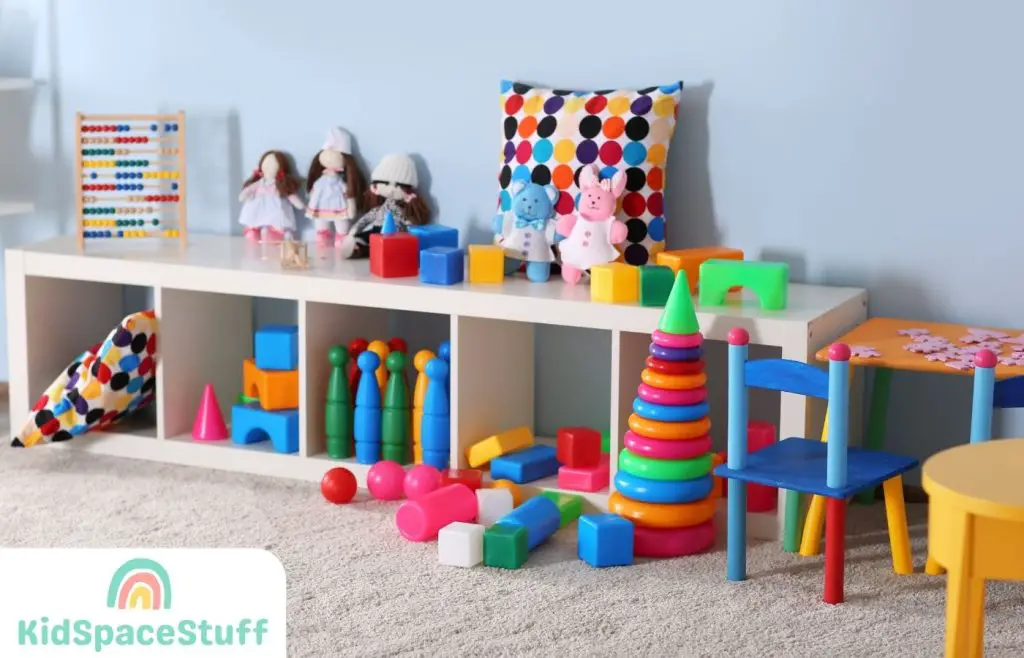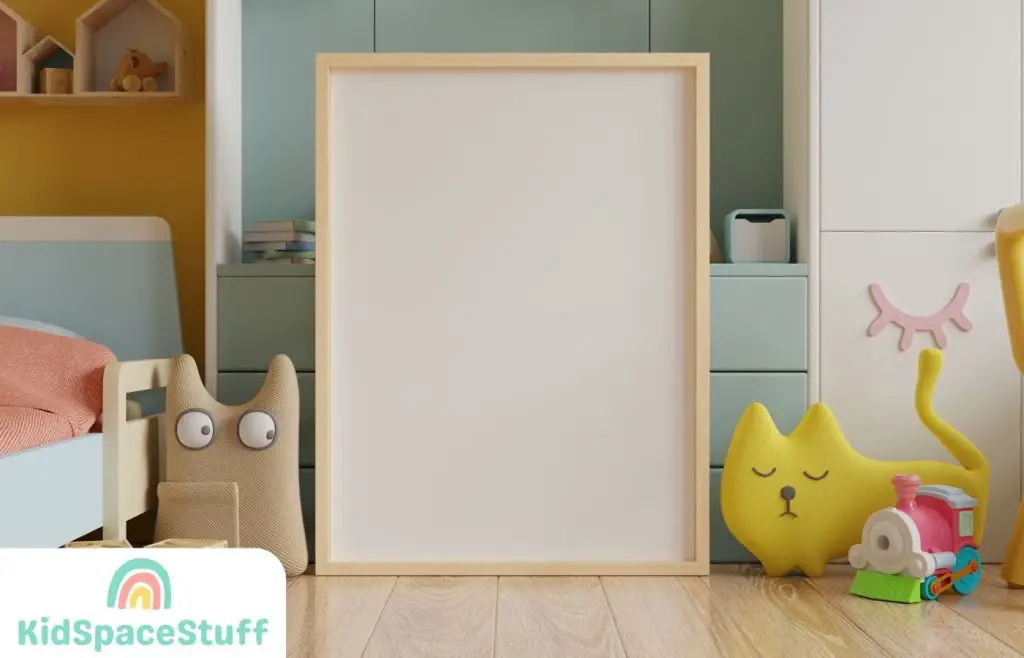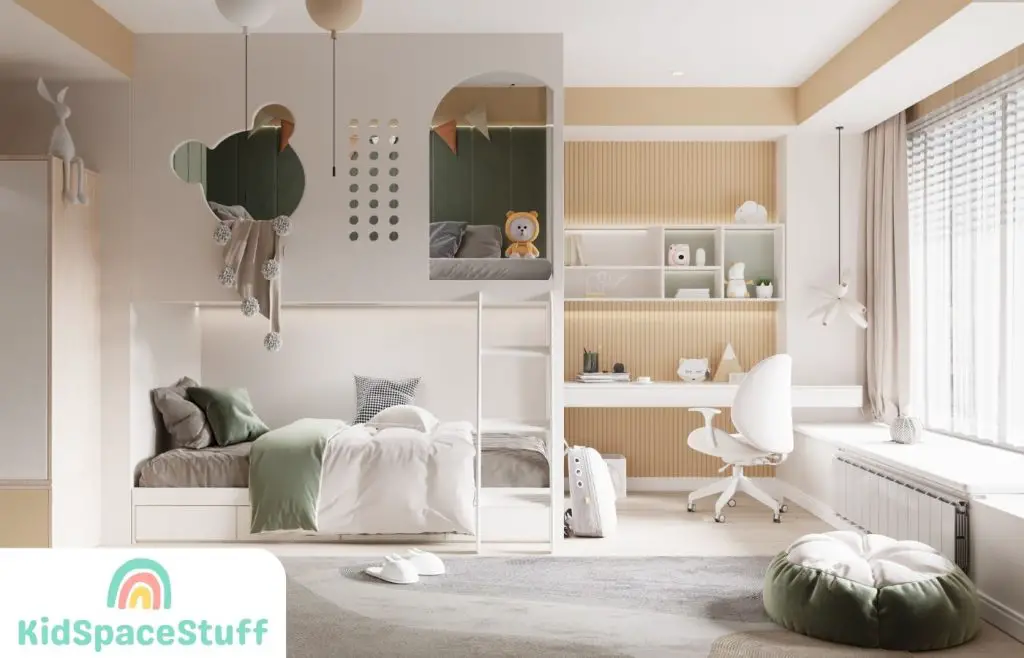When it comes to designing a child’s room, selecting the perfect flooring might not be the first thing that comes to mind.
As an experienced interior designer, I can assure you that it’s just as crucial as picking the right wall color or the perfect bed. The floor is not just a surface your kids walk on—it’s a play area, a stage for imaginative adventures, a cozy spot for late-night chats, and yes, sometimes a canvas for artistic endeavors.
In this article, I’ll guide you through some of the best flooring options for children’s rooms, highlighting what makes each one uniquely suited to the joys and challenges of childhood.
- There are many different types of flooring options that can be great for kids rooms.
- Carpet, vinyl, hardwood, and even tile can be great options depending on your budget and age of your kids.
- The type of flooring used can affect not only the look of your room, but also the comfort and noise reduction.
Kids Room Flooring Ideas
Carpet: Soft, Warm, and Cushioning

Carpet is a popular choice for children’s rooms, and for good reasons. Its soft texture and warmth underfoot make it a comfortable option for little ones who spend a lot of time playing on the floor. Additionally, it acts as a cushion for accidental falls and muffles noise, which is a huge plus if you have active children.
Carpeting comes in a vast array of colors and patterns, making it easy to find something that fits your child’s personality and the room’s overall aesthetic. From subtle neutrals to bright, whimsical patterns, the choices are almost limitless. For example, if you’re working on a home school room – carpet can be an excellent choice that I would recommend.
However, it’s worth noting that carpet can be more challenging to keep clean than some other types of flooring. Spills, stains, and dust can be issues. Fortunately, many modern carpets come with stain-resistant treatments, and regular vacuuming can help keep allergens at bay.
Laminate: Durable, Easy to Clean, and Budget-Friendly
If you’re looking for a flooring option that is robust, easy to maintain, and friendly on the budget, laminate flooring could be an excellent choice. Laminate can mimic the look of hardwood, tile, or stone without the high cost and upkeep. This makes it particularly appealing for children’s rooms, where spills, messes, and high-traffic wear and tear are the norms.
Laminate flooring is resistant to stains and damage, and its smooth surface makes it easy to clean up spills or wipe away marks. However, it can be slippery when wet, and it doesn’t offer the same warmth and cushioning as carpet. Area rugs can mitigate these downsides, providing a soft, cozy play area while maintaining the practical benefits of laminate flooring.
Vinyl: Water-Resistant, Comfortable, and Versatile
Vinyl flooring, especially luxury vinyl, has become increasingly popular in recent years. It’s water-resistant, making it an excellent option for kids who love to bring their drinks or art projects into their rooms. It’s also softer and warmer underfoot compared to tile or stone, which adds to its comfort level.
One of the most appealing aspects of vinyl flooring is its versatility. You can find it in a range of styles, colors, and patterns, including designs that closely mimic wood or tile. This allows you to achieve a specific look without sacrificing practicality. Additionally, vinyl is known for its durability and easy maintenance, making it a great long-term choice.
Cork: Eco-Friendly, Warm, and Soft
For eco-conscious families, cork flooring is worth considering. Cork is a renewable resource and offers several properties that make it suitable for a child’s room. It’s warm, soft, and has a slight bounce to it, making it comfortable for play and reducing the impact of falls.
Cork also has excellent insulating properties, helping to keep the room warm in winter and cool in summer. It’s also naturally resistant to mold, mildew, and allergens, which can contribute to a healthier indoor environment.
The main downside is that cork can be prone to scratches and dents, so it may not be the best choice for rough-and-tumble play. However, many of these marks can be sanded out, and the natural pattern of cork helps hide minor damage.
Hardwood: Classic, Durable, and Long-Lasting

Hardwood floors are a classic choice and can add a sense of warmth and elegance to any room. In a child’s room, hardwood has the advantage of being long-lasting and able to withstand the test of time. As your child grows, the floor can grow with them, adapting to new themes and décor choices.
Hardwood is easy to clean and can be refinished multiple times to deal with any scratches or dents. An area rug can add a layer of comfort for play and provide a pop of color or pattern. The main drawback of hardwood is its cost, but many homeowners see it as an investment that adds value to the home over time.
Tile: Hygienic, Cool, and Low Maintenance
Tile flooring is another option to consider for a child’s room, especially if you live in a warmer climate, as tile can help keep the room cool. Ceramic or porcelain tiles are low maintenance, stain-resistant, and easy to clean, which can be a big plus with kids.
Tiles also offer an opportunity for creative design. They come in a variety of colors, shapes, and sizes, allowing you to create unique patterns or colorful mosaics that can add personality to the room.
However, keep in mind that tile is a hard and cold surface, which may not be the most comfortable for playtime. To counter this, consider using area rugs to provide softer, warmer areas for your child to sit and play. Also, remember that tile can be slippery when wet, so immediate cleanup of any spills is important.
Concrete: Modern, Durable, and Customizable
You may not immediately think of concrete as a flooring option for a child’s room, but it has many benefits that make it worth considering. For one, it’s incredibly durable and can withstand almost anything your child can throw, drop, or spill on it.
Concrete flooring can be surprisingly versatile from a design perspective. It can be stained, painted, or sealed in almost any color, and finishes can range from smooth and glossy to textured, giving you plenty of customization options. This allows you to create a floor that matches the room’s aesthetic, whether that’s bright and playful or sleek and modern.
Concrete is also low maintenance and easy to clean, making it a practical choice. However, like tile, it’s a hard surface and can be cold underfoot. Area rugs or foam play mats can make the floor more comfortable for play and help to warm up the space.
Why Flooring Type Matters in a Kid’s Room

When designing a child’s room, you might ask, why does the type of flooring really matter? After all, isn’t it just a surface to walk on? As an experienced interior designer, I can tell you that the floor is so much more than that. Here’s why the type of flooring you choose can make a significant impact in a child’s room.
Safety
First and foremost, safety is paramount in any space designed for children. Kids spend a lot of their time playing, often on the floor, and accidents can happen. Certain types of flooring, such as carpet, offer a softer landing for those inevitable slips and falls, while others, like tile and concrete, are harder and may require additional safety considerations like area rugs or play mats.
Comfort
Comfort is another key factor. A comfortable child is a happy child, and the flooring can contribute a lot to the overall comfort of a room. Carpet, cork, and to some extent, vinyl and laminate, provide a warmer, softer surface that’s more comfortable for sitting, playing, and sometimes even napping. Hard surfaces like tile, concrete, and hardwood might not be as cozy, but they can be warmed up with rugs.
Durability and Maintenance
Children are tough on floors. Between art projects, snack time, indoor games, and just the daily wear and tear, floors in children’s rooms need to be durable and easy to clean. Flooring like laminate, vinyl, tile, concrete, and hardwood can stand up to a lot of abuse and are generally easier to clean than carpet. However, certain carpets are designed to be highly stain-resistant and durable, standing up well to the demands of a child’s room.
Noise Reduction
If you’ve ever lived in a house with kids, you know that noise can be an issue. Here too, the choice of flooring can make a difference. Soft flooring like carpet and cork can significantly reduce noise, absorbing the sounds of play and footsteps. This can be particularly beneficial in multi-story homes where sound can easily travel to other parts of the house.
Aesthetics
Finally, let’s not forget about aesthetics. A child’s room is their sanctuary, and it should reflect their personality and interests. The color, pattern, and texture of the flooring can significantly influence the room’s look and feel. With the wide variety of flooring options available today, you can find something that fits any theme or color scheme.
Here’s a great video that can help you decide which flooring option is best for your room!
Final Thoughts
In conclusion, the best flooring for a child’s room depends on many factors, including your budget, your child’s activities, the room’s décor, and personal preference. Each option has its strengths, and understanding these can help you make the most informed decision. Ultimately, the goal is to create a safe, comfortable, and appealing environment that your child can enjoy for many years.
KidSpaceStuff is a site dedicated to helping parents find the best interior design, activities, and inspiration for their kids.